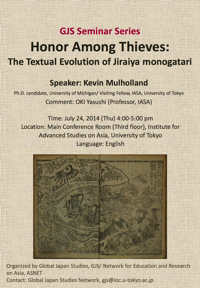GJS SeminarHonor Among Thieves: The Textual Evolution of Jiraiya monogatari
| Time: | July 24, 2014 (Thu) 4:00-5:00 pm |
|---|---|
| Location: | Main Conference Room (3rd floor), Institute for Advanced Studies on Asia, University of Tokyo |
| Speaker: | Kevin Mulholland (Ph.D. candidate, University of Michigan/Visiting Fellow, Institute for Advanced Studies on Asia, University of Tokyo) |
| Language: | English |

Abstract:
Now Jiraiya is inseparably associated with ninjutsu and frogs, but his first appearancein Japanese literature is that of a valiant thief(/gizoku/) with questionable honor.This talk addresses the fundamental concern of literary studies, the nature of the text,by tracing the textual evolution of /Jiraiya monogatari/, or /The Tale of Jiraiya/.Overshadowed by Santô Kyôden’s /Chûshin suikoden/ and Kyokutei Bakin’s/Nansô Satomihakkenden/, both Kanwatei Onitake’s /Katakiuchi Jiraiya monogatari /(1806) and his/Jiraiya monogatari kôhen/ (1807) occupy an important position within a field of earlymodern Japanese narratives at a moment of transition. The success of these two booksquickly inspires the publication of two stage adaptations, Chikamatsu Tokusô’s /YaemusubiJiraiya monogatari/ (1807) and /Kabuki seikô gekidana no shûshoku Jiraiya monogatari /(1809).The staging of these plays gives Jiraiya a life of his own, which culminates in the immenselypopular /gôkan//Jiraiya gôketsu monogatari/ (1839-1868). Spanning nearly three decades,/Jiraiya gôketsu/ /monogatari /begins conscious of the archetypes set in Kanwatei’s originalwork, but the nature of the Jiraiya character changes to suit the trends of the /gôkan /mediumand the need for serialization. An exploration of these different instantiations of the /Jiraiyamonogatari/ narrative reveals several aspects of how early modern Japanese narratives changed overthe 19th century, including, the relationship of oral storytelling to the novel form, the role ofthe book trade between Edo and Osaka in the formation of narratives, the interactions between printand stage, and the impact visual-verbal print has in redefining the nature of a character.



